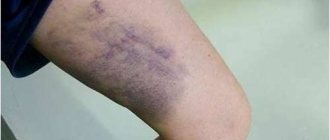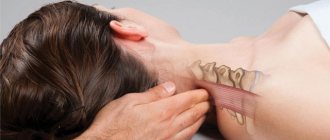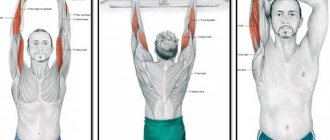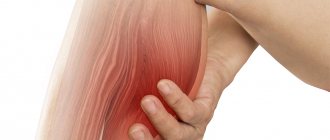Mild numbness of the neck may be present in a practically healthy person after prolonged wearing of clothes with pressure collars. At the site of compression, blood microcirculation is disrupted and this can cause a temporary feeling of numbness. But if numbness in the neck area is constantly present and does not go away, then you need to see a neurologist as soon as possible. This doctor will be able to determine the potential cause of this symptom and prescribe effective and safe treatment.
It is important to understand that pain and numbness in the neck is not an independent condition. It can only occur if pathological changes develop in different tissues of the spinal column and the fibers surrounding them. The spinal column is conventionally divided into 5 sections: cervical, thoracic, lumbar, sacral and coccyx. The cervical region is quite functionally loaded. He is responsible for all head movements. Here is a section of the spinal cord that is responsible for the innervation of the tissues of the head, including the tongue, larynx, palatine tonsils, etc. The radicular nerves arising from the C6 vertebra are responsible for the innervation of the muscles and epidermis of the neck, back of the head and shoulders. Therefore, numbness most often occurs when the C6-C7 intervertebral disc is damaged.
If the C7-T1 intervertebral disc is involved in the process, then numbness also occurs in the upper limb on the affected side. Knowing this toponymy, an experienced neurologist will be able to quickly identify the potential location of tissue damage. Then he will have to identify what exactly is being pressed on the radicular nerve. Depending on the nature of the manifestation of clinical symptoms, he may suspect either an intervertebral hernia or myositis with calcification of inflammatory foci.
The cervical spine consists of 7 vertebral bodies. There is no intervertebral cartilaginous disc between the first and second. Here is the joint with which the atlas connects to the second cervical vertebra. This provides a high range of mobility of the cranium.
Between the bodies of the remaining vertebrae are cartilaginous intervertebral discs. Each of them consists of a dense fibrous ring and a gelatinous internal body - the nucleus pulposus. This design ensures uniform distribution of the shock-absorbing load and protects the radicular nerves extending from the spinal cord from pressure from the vertebral bodies they separate.
Each root nerve includes three types of nerve fiber: sensory (sensitive), motor (motor and mixed. According to the sensory type of nerve fiber, information is received from the skin and muscles to the brain structures about the state of tissues, their interaction with the environment. If sensory the type of nerve fiber is damaged by compression, traumatic, ischemic or due to inflammation, then information is not transmitted.This is felt as numbness.
This is a very unfavorable clinical sign. It indicates that the integrity of the nerve fiber is damaged and subsequently it may not be restored. The patient will still have a feeling of numbness, and other neurological problems may develop later.
If such a sensation occurs, you should seek medical help from a doctor as soon as possible. This could be a neurologist or vertebrologist. In Moscow, you can make a free appointment with these specialists at our manual therapy clinic. Experienced doctors will conduct a full examination, make a preliminary diagnosis, and give recommendations regarding additional examination and subsequent treatment.
To make an appointment for a free appointment, call the clinic administrator or contact him in any other way convenient for you. You can fill out the feedback form located on this page. A specialist will contact you and agree on a time convenient for your visit to us.
Causes of neck numbness
As mentioned above, the feeling of numbness in the neck can be a temporary, physiological phenomenon. For example, if a person has been in a static, uncomfortable position for a long time (sleeping with an incorrect head position), then a zone of temporary degeneration of the nerve fiber responsible for the innervation of the area of numbness will form. Immediately after restoration of blood microcirculation, sensitivity is restored. First there is a tingling sensation, then there is full sensitivity in its entirety.
If a focus of numbness appears in the neck area and does not go away within 30–40 minutes or a longer period of time, then this is the result of pathological changes in the tissues of the spine.
Potential causes of neck numbness include diseases such as:
- degenerative dystrophic damage to the cartilage tissue of the intervertebral discs (osteochondrosis);
- its complications, such as protrusion (decrease in height), extrusion (rupture) and intervertebral hernia (exit of part of the nucleus pulposus through a gap in the fibrous ring);
- cicatricial deformation of ligamentous, tendon and muscle fibers (most often develops after sprains and microscopic tears);
- unstable position of the vertebral bodies in the cervical region and their periodic displacement relative to each other according to the type of retrolisthesis and antelesthesis;
- deforming spondyloarthrosis in the cervical region;
- systemic lupus erythematosus, ankylosing spondylitis, multiple sclerosis and other types of rheumatic lesions of nervous and cartilage tissue;
- curvature of the spine and poor posture (in women over 45 years of age, this is often caused by growing withers);
- stenosis of the spinal canal, including due to the development of tumors and infectious processes;
- inflammation of the hard membranes of the spinal cord;
- damage to the radicular nerves of a trophic, traumatic and ischemic nature (radiculitis);
- excessive tension of the muscle fiber in the area of pathology development;
- inflammation or compression of the cervical plexus (plexitis).
This is not a complete list of possible pathologies that manifest as numbness and pain in the neck. Only a doctor can determine the exact cause of the appearance of such clinical symptoms during an examination. Therefore, you should not engage in self-diagnosis.
To prevent and alleviate your condition, you can exclude from your life possible negative influence factors that may lead to the development of certain diseases:
- excess body weight - every extra kilogram has a significant impact on the spinal column;
- maintaining a sedentary lifestyle and sedentary work, with prolonged tension in the muscles of the neck and collar area;
- traumatic effects on the neck area, including wearing tight clothing with pressing collars;
- smoking and drinking alcoholic beverages;
- lack of regular physical activity;
- violation of ergonomic rules when organizing sleeping and working spaces;
- risk of falling, emergency braking when driving in a car.
These risk factors are highly likely to provoke the destruction of cartilaginous intervertebral discs. As a result of this, the patient may develop osteochondrosis, osteoarthritis, intervertebral hernia and a number of other diseases, manifested by a feeling of numbness in the neck, back of the head, shoulders and upper extremities.
Why does my neck get stiff?
What is the lifestyle of a modern person? Let's imagine the most ordinary office employee. He sits in a chair for 8–9 hours, breaking for a cup of coffee and lunch. There is a screen in front of his eyes that he looks at all the time. And this is how most of the week goes.
On weekends, the most ordinary office worker is at home or at a bar with friends, where he again sits or lies. What happens to the muscles? Little blood flows into them, they become numb. As a result of this, the vertical load on the spine is no longer shared between it and the muscles and falls entirely on the skeleton.
The spinal cord is located in the spine, the roots of which extend beyond the spinal canal. In these places, in this state of affairs, pinching of the spinal roots occurs, as a result of which the person feels numbness in the limbs and pain.
In addition to all this, the blood supply to the brain is disrupted, because the neck is a strategically important bridge between the body and the neck. Hence the headaches.
So, why can your neck go numb?
- Long absence of mobility, change of positions.
- Short-term or long-term stay in positions that are very uncomfortable for the neck (most often during sleep).
- Cold.
Feeling of numbness in the neck - where to go
If you have a feeling of numbness in your neck, you need to make an appointment with a neurologist. This specialist has the necessary level of professional competence to identify the potential cause and eliminate it.
In most cases, numbness in the back of the neck is caused by osteochondrosis and its complications. In this situation, the best choice would be a vertebrologist. This doctor will be able to develop a course of restorative therapy, thanks to which you will be able to completely restore the lost health of the spinal column.
If numbness in the skin of the neck or muscles appears after a traumatic impact (fall, blow, participation in an accident, or simply emergency braking while driving in a car with the head thrown back), then you should immediately visit a traumatologist. This doctor will order an x-ray to rule out the possibility of a fracture or crack in the bone tissue of the spinal column. This is a very dangerous condition in which complete paralysis of the entire body can quickly develop. Therefore, you should not hesitate to seek medical help.
After contacting a neurologist or vertebrologist, an X-ray examination will also be prescribed. It will reveal indirect signs of the development of osteochondrosis (decrease in the height of the intervertebral spaces), deforming spondyloarthrosis (narrowing of the joint space), the development of osteophytes and disruption of the position of the vertebral bodies with their possible displacement. For further diagnosis, you will need to conduct an MRI examination, ultrasound examination of the vessels of the neck and brain. Consultation with an otolaryngologist, pulmonologist and cardiologist may be required.
If numbness of the neck muscle is caused by endocrine and vascular problems, such as diabetic angiopathy or atherosclerosis, then additional treatment will be required from an endocrinologist and vascular surgeon.
Treatment of numbness in the neck, neck and shoulders
In order to begin effective and safe treatment, you must first make an accurate diagnosis. Then the doctor must try to eliminate the factor that interferes with the conduction of the nerve impulse along the sensory types of axons.
For example, if numbness of the neck and shoulders is associated with infiltrative edema due to congestion or an inflammatory aseptic reaction, then several sessions of osteopathy will help. An experienced doctor will restore physiological microcirculation of blood and lymphatic fluid. The pressure on the sensory axons will ease. This will help restore sensitivity in the area of pathological changes.
If numbness of the neck and back of the head is a symptom of osteochondrosis, then first of all it is necessary to restore the normal height of the intervertebral spaces. To do this, it is advisable to use the technique of manual traction of the spinal column. During the procedure, an experienced doctor will remove compression from the radicular nerves and their branches. It will restore the normal height of the intervertebral spaces. The cartilage tissue is straightened. This will promote the regeneration process.
But the elimination of pain and numbness does not mean that the disease is completely defeated. It is necessary to continue treatment until the damaged tissue is completely restored. For these purposes, the doctor develops an individual course of therapy. Depending on the identified disease, it may include the following types of exposure:
- massage of the neck and collar area - restores the normal tone of the muscle fiber, returning its ability to provide complete diffuse nutrition to the cartilage tissue of the intervertebral discs;
- osteopathy – starts the process of enhancing the trophism of all tissues, normalizes the elasticity of ligament and tendon fibers, eliminates the risk of fluid stagnation and the development of infiltrative edema of soft tissues;
- physiotherapy improves metabolism at the cellular level, accelerates regeneration processes;
- reflexology triggers tissue regeneration by tapping into the hidden reserves of the human body;
- Therapeutic gymnastics and kinesiotherapy strengthen the muscle frame and improve the condition of all tissues.
The course of treatment is developed for each patient individually. If you need help with neck numbness, make an appointment for a free appointment with our doctors at a manual therapy clinic in Moscow. You will be provided with comprehensive information about the possibilities and prospects for using our methods in your case of illness.
How to keep your neck ok
There are several ways to protect yourself from neck problems. Surely you have met people in your life, or maybe you yourself have been in situations where your neck hurts from chronic tension or a draft.
In this state, a person cannot turn his head, and this is very uncomfortable. To avoid such situations (it’s impossible to avoid them 100%, because anything can happen in life, but you can minimize the risk of such an incident), you need to do this.
Convenience of poses
When you are at work, try to ensure right angles everywhere. This means that the angle of your body's bending at the knees and pelvis should be 90 degrees. Ideally, the center of the PC screen should be at eye level in this position. This is possible; in this position you will be less tired.
This advice is not only intended for those who have tense back and neck muscles. We recommend this scheme in the workplace to everyone who wants to avoid problems such as chronic tension.
When you sleep, pay attention to the bed. The sleeping surface should be flat; bending of the neck is unacceptable. An important part of a comfortable sleep is the pillow. We highly recommend purchasing an orthopedic pillow. Lie on it once. Believe me, you will rethink a lot.
When your neck is tense, using a pillow can help provide rest. This is a proven option. And if you sleep in an uncomfortable position, then daytime tension, combined with nighttime tension, will turn your neck muscles into stone. In the morning you will have difficulty turning your head, or it will hurt.
Warm
You need to take care of a stiff neck, create comfortable conditions for it, and wrap it in a scarf. No joke, try to protect your neck.
If you sleep in a draft for one night, the next morning you will wake up with a hellish pain in your neck and will not be able to turn your head. This is already inflammation of the muscle. But all this could have been avoided.
Always wear scarves in winter unless your jacket has a high zip collar. Take care of the back of your head, this is where the tendons are attached. This is a very vulnerable place.
Massage and special exercises
Massage
Now let's talk about the most pleasant part of our conversation today - massage. When you feel stiff, you can ask a loved one to rub your neck. Neck and shoulder massage perfectly relieves fatigue. In some cases, it encourages sleep.
You can give yourself a massage. The technique will be like this:
- While sitting, clasp your head on both sides with your hands, place your fingers on the back of the head. Feel the tubercle on the back of your head - the tendons from the muscle are attached to it from below. Massage the area with your fingers. Next, with massaging movements, go down to the base of the neck. Walk up and down several times, making pressing and circular movements with 4 fingers of each hand.
- Now walk your hands from your neck to your shoulders. This is the top of the trapezoids, crush them mercilessly on the verge of pain and euphoria. If they are hard, knead them until they become like dough.
- To keep your trapezius from being tense, rest your elbows on the table. In a suspended state, they hold your hands so that they do not fall down.
- When you massage the back of your head and neck, place your head on books or somewhere else with your forehead so that the muscles do not strain to maintain the position.
- Using your fingers, lightly press and stroke the front of the neck to the right and left of the Adam's apple. Attention! This is where the pressure points are located, and where important blood vessels pass, so apply very little pressure so that it feels pleasant. Don't make sudden movements.
- The trapezius muscle is considered part of the back, so these tips also apply to the question of how to relax the back muscles.
The most pleasant places for massage are the back of the head and the top of the trapezius. The top of the trapezius connects the shoulder girdle and neck. This part of the muscle bears a huge load to fix the arms. If it weren't for them, our hands would drop to our knees. But the muscular mechanism prevents this from happening.
Friends, a relaxing massage is truly a healing thing! Once every 3 months it is very useful and healthy to take a course of back and neck massage.
But keep in mind that the massage must be done by a good specialist with the appropriate documents. Careless handling of your back and neck can cause harm!
Exercises
If you have tense neck muscles, special exercises will help you. There are several complexes that allow for the prevention of such phenomena.
The first complex is based on neck movements. Your task is to make circular movements in all directions, tilt your neck to the side, forward and backward. Moreover, with each inclination and circle, try to increase the amplitude of movement. All movements are performed slowly and thoughtfully. You can’t rush here, because careless and sudden muscle stretching can complicate your situation.
The second option is isometric loading. Scientists have concluded that after such tension the muscle should relax. This is true, relaxation comes after intense stress. On the one hand, it is absurd to strain an already tense muscle. On the other hand, it works.
The next complex is based on the principle of isometry. It can be performed while sitting right at your workplace (just so that the boss does not see):
- Sit up straight, tilt your head with your chin down. Place your hands around the back of your head. Try to raise your head, and use your hands to prevent this from happening. A tension will develop at the back of the neck, which must be held for 5-10 seconds. Relax and wait 20 seconds. Repeat the exercise 3 times.
- Now grab the left side of your head with your right hand and press it towards your right shoulder. If stretching does not allow, bend it as much as you can. Try to bring your head back, but don't let your hand do it. Hold the tension for 5-10 seconds. Repeat the exercise three times, each time tilting your head more and more.
- Place your elbows on the table, your head on your palms. Tighten your neck as if you are reaching your chin towards your neck. Your hands are in your way. Hold the tension for up to 10 seconds. Do this three times.
After all, rub the neck muscles by stroking. Charging is complete, nothing should leak in the next few hours! In general, warm up more often, tilt your neck to the right and left, and make circular movements. Muscles love mobility!










